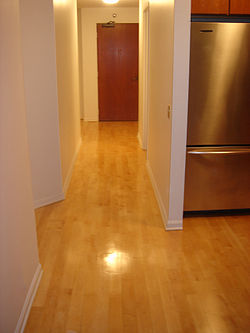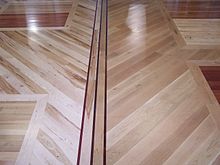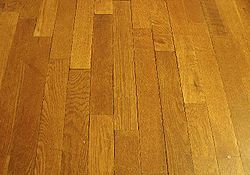The following article was sourced from a Wikipedia page at the following address: http://en.wikipedia.org/wiki/Wood_flooring
WOODEN FLOORING

An example of solid wood flooring with a top coating of polyurethane
Wood flooring is any product manufactured from timber that is designed for use as flooring, either structural or aesthetic. Wood is a common choice as a flooring material due to its environmental profile, durability, and restorability. Bamboo flooring is often considered a form of wood flooring, although it is made from a grass (bamboo) rather than a timber.
TYPES
Solid
Hardwood flooring
Solid hardwood floors are made of planks milled from a single piece of timber. Solid hardwood floors were originally used for structural purposes, being installed perpendicular to the wooden support beams of a building known as joists or bearers. With the increased use of concrete as a subfloor in some parts of the world, engineered wood flooring has gained some popularity. However, solid wood floors are still common and popular. Solid wood floors have a thicker wear surface and can be sanded and finished more times than an engineered wood floor. It is not uncommon for homes in New England, Eastern Canada, and Europe which are several hundred years old to have the original solid wood floor still in use today.

Custom Showroom
Solid wood manufacturing
Solid wood flooring is milled from a single piece of timber that is kiln or air dried before sawing. Depending on the desired look of the floor, the timber can be cut in three ways: flat-sawn, quarter-sawn, and rift-sawn. The timber is cut to the desired dimensions and either packed unfinished for a site-finished installation or finished at the factory. The moisture content at time of manufacturing is carefully controlled to ensure the product doesn't warp during transport and storage.
There are a number of proprietary features for solid wood floors that are available. Many solid woods come with grooves cut into the back of the wood that run the length of each plank, often called 'absorption strips,' that are intended to reduce cupping. Solid wood floors are mostly manufactured .75 inches (19 mm) thick with a tongue-and-groove for installation.
Other wood manufacturing styles
Rotary-peel
This process involves treating the wood by boiling the log in water at a certain temperature for a certain amount of time. After preparation, the wood is peeled by a blade starting from the outside of the log and working toward the centre, thus creating a wood veneer. The veneer is then pressed flat with high pressure. This style of manufacturing tends to have problems with the wood cupping or curling back to its original shape. Rotary-peeled engineered hardwoods tend to have a plywood appearance in the grain.
Sliced-peel
This process begins with the same treatment process that the rotary peel method uses. However, instead of being sliced in a rotary fashion, with this technique the wood is sliced from the log in much the same manner that lumber is sawn from a log – straight through. The veneers then go through the same manufacturing process as rotary peeled veneers. Engineered hardwood produced this way tends to have fewer problems with "face checking", and also does not have the same plywood appearance in the grain. However, the planks can tend to have edge splintering and cracking due to the fact the veneers have been submersed in water and then pressed flat.
Dry solid-sawn
Instead of boiling the hardwood logs, in this process they are kept at a low humidity level and dried slowly to draw moisture from the inside of the wood cells. The logs are then sawed in the same manner as for solid hardwood planks. This style of engineered hardwood has the same look as solid hardwood, and does not have any of the potential problems of "face checking" that rotary-peel and slice-peel products have, because the product is not exposed to added moisture.
Engineered

Wood flooring is a popular feature in many houses.
Engineered wood flooring is composed of two or more layers of wood in the form of a plank. The top layer (lamella) is the wood that is visible when the flooring is installed and is adhered to the core. The increased stability of engineered wood is achieved by running each layer at a 90° angle to the layer above. This stability makes it a universal product that can be installed over all types of subfloors above, below or on grade. Engineered wood is the most common type of wood flooring used globally.
There are several different categories of engineered wood flooring:
All timber wood floors are made from sawn wood and are the most common category of engineered wood flooring. They do not use rotary peeled veneer, composite wood (such as HDF), or plastic in their construction.
Veneer floors use a thin layer of wood over a core that is commonly a composite wood product.
Acrylic impregnated wood flooring uses a layer of wood that is impregnated with liquid acrylic then hardened using a proprietary process.
Laminate and vinyl floors are often confused with engineered wood floors, but are not—laminate uses an image of wood on its surface, while vinyl flooring is plastic formed to look like wood.
Engineered wood flooring manufacturing
Lamella
The lamella is the face layer of the wood that is visible when installed. Typically it is a sawn piece of timber.
The timber can be cut in three different styles: flat-sawn, quarter-sawn, and rift-sawn. Each will lend the board a different appearance.
Core/substrate
Wood ply construction ("sandwich core"): Uses multiple thin plies of wood adhered together. The wood grain of each ply runs perpendicular to the ply below it. Stability is attained from using thin layers of wood that have little to no reaction to climatic change. The wood is further stabilized due to equal pressure being exerted lengthwise and widthwise from the plies running perpendicular to each other.
Finger core construction: Finger core engineered wood floors are made of small pieces of milled timber that run perpendicular to the top layer (lamella) of wood. They can be 2-ply or 3-ply, depending on their intended use. If it is three ply, the third ply is often plywood that runs parallel to the lamella. Stability is gained through the grains running perpendicular to each other, and the expansion and contraction of wood is reduced and relegated to the middle ply, stopping the floor from gapping or cupping.
Fibreboard: The core is made up of medium or high density fibreboard. Floors with a fibreboard core are hygroscpoic and must never be exposed to large amounts of water or very high humidity - the expansion caused from absorbing water combined with the density of the fibreboard, will cause it to lose its form. Fibreboard is less expensive than timber and can emit higher levels of harmful gases due to its relatively high adhesive content.
An engineered flooring construction which is popular in parts of Europe is the hardwood lamella, softwood core laid perpendicular to the lamella, and a final backing layer of the same noble wood used for the lamella. Other noble hardwoods are sometimes used for the back layer but must be compatible. This is thought by many to be the most stable of engineered floors.
Aesthetics
Engineered wood flooring is mainly industrially fabricated in the form of straight edged boards, with milled jointing profiles to provide for interconnecting of the boards. Such manufacturing is most cost efficient but leaves an industrial looking surface. In nature no straight lines exist; therefore there is a rising trend to modify the visual appearance to imitate it. In recent years numerous producers have been taking on the challenge of adding more natural aesthetics.
For instance - some manufacturers have come up with an idea to use, instead of straight edged boards, un-edged planks with wood trunk curvature. This method, although providing a natural looking design has the disadvantage of requiring a large amount of raw material. The lamellas which form are scanned by a computer and fitted together to match the forms of the following un-edged lamella. This method, although providing a natural looking design and using quite efficiently the raw material, makes this kind of flooring very expensive and unaffordable to the general public.
A method, developed and protected as intellectual property by engineered flooring producer "ESTA parket", is milling the raw material in predefined amount of predefined forms inspired by nature, to form a system. The predefined forms are chosen so as to fit together with adjacent boards and adjacent systems; to provide for infinitely extendible surface covering composing of non-straight edged boards. This method provides unique nature inspired aesthetics while being industrially manufacturable with moderate costs to the consumer.
COMPARISON OF SOLID WOOD WITH ENGINEERED WOOD
It is difficult to compare solid wood flooring to engineered wood flooring due to the wide range of quality in both product categories, particularly engineered. There are some limitations of solid wood: There are recommended maximum lengths and widths, typically 5" / 127mm wide and 7' / 2100mm long. Solid hardwood is also more prone to "gapping" (excessive space between planks), "crowning" (convex curving upwards when humidity increases) and "cupping" (a concave or "dished" appearance of the plank, with the height of the plank along its longer edges being higher than the centre) with increased plank size. Solid wood can be used with under floor radiant heating. However extra care is necessary with the planning and installation of the heating system and the wood flooring, such as limiting the temperature to 85 °F (29 °C), avoid sharp temperature fluctuations, utilizing an outdoor thermostat to anticipate heating demands, and monitoring the moisture content for the subfloor before installation.
There are some characteristics that are common to each category: solid wood is more frequently site-finished, is always in a plank format, is generally thicker than engineered wood, and is usually installed by nailing. Engineered wood is more frequently pre-finished, has bevelled edges, is very rarely site-finished, and is installed with glue or as a floating installation.
Engineered wood flooring has other benefits beyond dimensional stability and universal use. Patented installation systems allow for faster installation and easy replacement of boards. Engineered wood also allows for a floating installation where the planks are not adhered to the subfloor or to each other, further increasing ease of repair and reducing installation time. Engineered flooring is also suitable for underfloor and radiant heating systems.
INSTALLATION SYSTEMS
Wood can be manufactured with a variety of different installation systems:
-
Tongue-and-groove: One side and one end of the plank have a groove, the other side and end have a tongue (protruding wood along an edge's centre). The tongue and groove fit snugly together, thus joining or aligning the planks, and are not visible once joined. Tongue-and-groove flooring can be installed by glue-down (both engineered and solid), floating (mostly engineered only), or nail-down (not recommended for most engineered).
-
"Click" systems: there are a number of patented "click" systems that now exist. These click systems are either "unilin" or "fiboloc" A "click" floor is similar to tongue-and-groove, but instead of fitting directly into the groove, the board must be angled or "tapped" in to make the curved or barbed tongue fit into the modified groove. No adhesive is used when installing a "click" floor, making board replacement easier. This system not only exists for engineered wood floors but also engineered bamboo and a small number of solid floors (such as "parador solido click") and is designed to be used for floating installations. It is beneficial for the Do-It-Yourself market.
-
Floor connection system: There are a wide range of connection systems, as most of them are mill-specific manufacturing techniques. The general principle is to have grooves on all four sides of the plank with a separate, unconnected, piece that is inserted into the grooves of two planks to join them. The piece used for the connection can be made from wood, rubber, or plastic. This installation system allows for different materials (i.e. wood and metal) to be installed together if they have the same connection system.
-
Wood flooring can also be installed utilizing the glue-down method. This is an especially popular method for solid parquet flooring installations on concrete sub-floors. Additionally, engineered wood flooring may use the glue-down method as well. A layer of mastic is placed onto the sub-floor using a trowel similar to those used in laying ceramic tile. The wood pieces are then laid on top of the glue and hammered into place using a rubber mallet and a protected 2x4 to create a level floor. Often the parquet floor will require sanding and re-finishing after the glue-down installation method due to the small size pieces.
FINISHING, BUFFING, AND SANDING
Floor finishes
The two most popular modern finishes for wood flooring are oil-modified urethane and water-based polyurethane. Within both categories there are many variations and other names used to describe the finish. Oil-modified urethane and water-based polyurethane also have very different refinishing and maintenance regimes.
-
Natural shellacs, lacquers, and varnishes were used in the past, as were waxes, often blended with oils.
-
Oil - Oiled floors have existed for several thousand years and is the most common floor finish used globally. Oil finished floors are made from naturally derived drying oils, and are not to be confused with petroleum based oils. Pre-finished oil floors can be UV cured. Most vegetable based oils are 100% natural and contain no VOCs.
-
Brushed and oiled - Steel brushes are used in the direction of the grain which opens up the surface of the wood and removes splinters. The wood is then oiled.
-
Polyurethane - Polyurethane floor finishes were first introduced around 1942. There are several types of polyurethane finishes that exist, but the two most common are oil-modified polyurethane and water-based polyurethane. A note to mention is water-base urethane is harder than OMU poly's and are much safer for the user.
Buffing
Generally Hardwood Floors need to be buffed every 3-5 years. The process usually takes about 1 day. Buffing refers to the process of using a stand up floor buffer. The floor is abasied with 180 grit screen on the buffer. This allows for the new coat of finish to mechanically adhere to the floor. This process works with great results as long as the floor hasn't had any waxes or synthetic cleaners.
Refinishing
Sanding the finish off old wood floors and soothing them out.
Floor sanding
Sanding provides a method for smoothing an installed floor, compensating for unevenness of the subfloor. Additionally, sanding is used to renew the appearance of older floors. Sanding using successively finer grades of sandpaper is required to ensure even stain penetration when stains are used, as well as to eliminate visible scratches from coarser sandpaper grades used initially. Prior to modern polyurethanes, oils and waxes were used in addition to stains to provide finishes. Beeswax and linseed oil, for example, are both natural crosslinking polymers are hardened over time.
MAINTENANCE
Proper use of vacuuming, sweeping, and damp mopping is usually all that is required to maintain the cleanliness and appearance of a wood floor. Oil soaps should not be used to clean the floors. The best suggestion is to use the manufacturer's recommended cleaning products. Excessive grit and foot traffic may affect appearance. A properly finished and maintained wood floor does not accumulate hidden soil or odorous compounds.
To read more about wooden flooring, please lick on the following link: http://en.wikipedia.org/wiki/Wood_flooring
